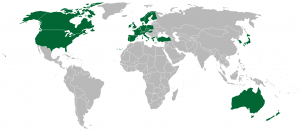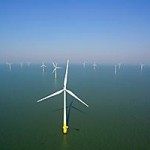By Guest blogger Angelika Pullen, Global Wind Energy Council
 Many developments in China can only be described in superlatives, and wind power is no exception. When I first visited Beijing to attend the ministerial Beijing Renewable Energy Conference (BIREC) in 2005, the city looked very different, and so did the wind energy industry. Back then, China only had around 1,000 MW of installed wind capacity, and when the government used the conference to announce its target of reaching 30 GW of wind capacity by 2020, this seemed nearly insanely ambitious.
Many developments in China can only be described in superlatives, and wind power is no exception. When I first visited Beijing to attend the ministerial Beijing Renewable Energy Conference (BIREC) in 2005, the city looked very different, and so did the wind energy industry. Back then, China only had around 1,000 MW of installed wind capacity, and when the government used the conference to announce its target of reaching 30 GW of wind capacity by 2020, this seemed nearly insanely ambitious.
And yet, a mere five years later, China has already achieved this target, 10 years early. Not only that – industry experts predict that at least 40 GW worth of wind turbines will be operating in China by the end of this year; possibly more. Given the current difficult situation in the US, there is even a distinct possibility that the world’s largest economy would have to cede its place as leading wind power country to China at the end of December this year. If that doesn’t happen, it almost certainly will in 2011.
What explains the dramatic growth of wind power in China? Genuine political commitment is certainly the deciding factor, something the US has been lacking to date. In 2005, the Chinese government passed the Renewable Energy law, which attracted both foreign and domestic investors to flock into the market. Nearly all large European, US and Indian wind turbine manufacturers established themselves in China to secure a piece of the (very large) cake. But China now also counts more than 30 domestic wind turbine manufacturers, three of which are now among the world’s leading suppliers, as well as an entire supply chain serving the industry.
 Wind power in New York could be increased in the next eight years by more than five times the amount currently operating in the state, a new study has found.
Wind power in New York could be increased in the next eight years by more than five times the amount currently operating in the state, a new study has found.
Continued wind development would bring a number of benefits to the 19.5 million people living in the state, including lowered energy production costs and decreased amounts of CO2 and other harmful pollutants, the study by the New York Independent System Operator (NYISO) found.
“Wind power is a vital component of New York State’s renewable energy strategy,” Stephen Whitley, NYISO president, said in a press release issued Thursday. “This study provides a much clearer picture of the benefits consumers can see as a result of continued wind development.”

IEA members
New figures from the International Energy Agency (IEA) show that wind energy is covering an impressive slice of the national electricity demand in countries around the world.
No stranger to being top of the wind energy league, in 2009 Denmark still showed the way with wind energy covering 19.3% of the national electricity demand. Coming in a surprise second on the IEA list is Portugal – last year wind covered 15% of the country’s electricity demand.
Portugal’s Iberian neighbour, Spain, falls third with 14.4% of the electricity demand met by wind power. Fourth and fifth position were awarded to Ireland and Germany with 10.5% and 6.5% respectively.
 A new milestone in offshore wind energy was reached today as the world’s largest offshore wind farm opened off the east coast of the UK. The Thanet wind farm in Kent comprises 100 turbines which will be able to produce 300 MW of electricity, enough to power more than 200,000 homes a year.
A new milestone in offshore wind energy was reached today as the world’s largest offshore wind farm opened off the east coast of the UK. The Thanet wind farm in Kent comprises 100 turbines which will be able to produce 300 MW of electricity, enough to power more than 200,000 homes a year.
Chris Huhne, UK environment secretary, is set to officially open the farm today. “We are an island nation and I firmly believe we should be harnessing our wind, wave and tidal resources to the maximum,” Huhne told the BBC.
Once Thanet is online, the amount of electricity generated by wind power in the UK will reach nearly 5 GW – or enough to power 3 million homes.
Maria McCaffery of Renewable UK said that Britain was on the verge of exporting wind powered electricity.
A new report has found that, in the long term, we can limit the global temperature rise to 1.5°C above pre-industrial levels. While this may make it sound like we are on the right path to preventing dangerous climate change – scientists say the rise should be kept to below 2°C – the emphasis on the ‘long term’ slightly distorts the picture since long term refers to the period after the year 2100.
More importantly we should note that the report, published by the Met Office Hadley Centre, the Grantham Research Institute on Climate Change and the Centre for Climate Change Economics and Policy, says while we can achieve a 1.5°C rise, this is highly likely to involve “temporarily overshooting the temperature goal for up to 100 years”.
 Rémi Gruet, Regulatory Affairs Advisor for EWEA, explains that such an overshoot could trigger the melting of permafrost soils: “Thawing soils would release methane – a gas more than 20 times more harmful to the climate than CO2,” Gruet says.
Rémi Gruet, Regulatory Affairs Advisor for EWEA, explains that such an overshoot could trigger the melting of permafrost soils: “Thawing soils would release methane – a gas more than 20 times more harmful to the climate than CO2,” Gruet says.
What we need now are early and strong emission reductions, he says; an opinion backed up by the report. To avoid the temperature overshoot, emissions reductions must begin now with the technologies we have available and are proven to work.
 Many developments in China can only be described in superlatives, and wind power is no exception. When I first visited Beijing to attend the ministerial Beijing Renewable Energy Conference (BIREC) in 2005, the city looked very different, and so did the wind energy industry. Back then, China only had around 1,000 MW of installed wind capacity, and when the government used the conference to announce its target of reaching 30 GW of wind capacity by 2020, this seemed nearly insanely ambitious.
Many developments in China can only be described in superlatives, and wind power is no exception. When I first visited Beijing to attend the ministerial Beijing Renewable Energy Conference (BIREC) in 2005, the city looked very different, and so did the wind energy industry. Back then, China only had around 1,000 MW of installed wind capacity, and when the government used the conference to announce its target of reaching 30 GW of wind capacity by 2020, this seemed nearly insanely ambitious.






 Comments
Comments



